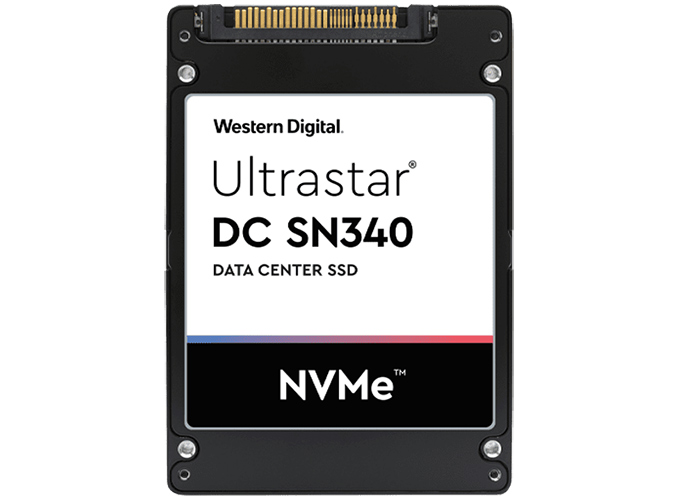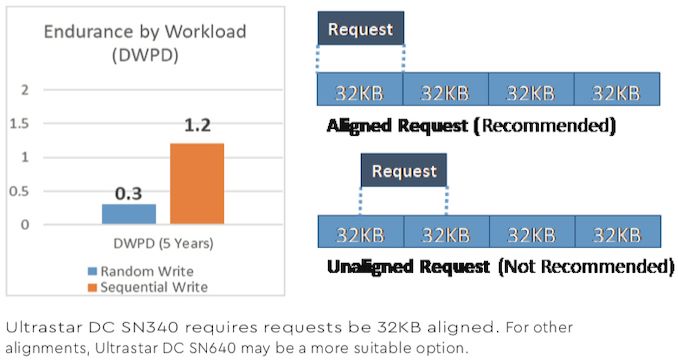Western Digital Reveals Ultrastar DC SN340 SSDs for Read Intensive Workloads
by Anton Shilov on August 7, 2019 2:00 PM EST- Posted in
- SSDs
- Storage
- Western Digital
- Enterprise SSDs
- NVMe
- U.2
- Ultrastar
- 3D TLC

Western Digital has introduced its new accelerator drives designed for very read-intensive workloads. The key feature of the Ultrastar DC SN340 Very Read Intensive (VRI) SSDs is their low read latency which is important for write-once read many applications, such as video-on-demand services, distributed databases, and emerging AI/ML workloads.
Nowadays video streaming providers use 1 TB SATA SSDs that offer a ratio of IOPS to bandwidth that satisfies their needs in terms of numbers of parallel users/streams (RIOPS). In a bid to optimize power, costs, and the number of racks in their datacenters while still meeting their requirements, VOD services need higher-capacity drives with higher performance and specific functionality. Western Digital believes that VRI SSDs is a type of devices that will satisfy requirements of the aforementioned (and many other read-intensive) workloads.
Carrying 3.84 or 7.68 TB of usable capacity, Western Digital’s Ultrastar DC SN340 U.2 drives optimized for write-once read many workloads are based on the company’s proprietary controller as well as 96-layer BiCS4 3D TLC NAND. With up to 3.3 GB/s sequential read speed, up to 1.5 GB/s write speed, up to 420K random read IOPS, and a 6.5 W maximum power consumption, the Ultrastar DC SN320 are substantially faster and more power efficient than SATA SSDs used by various VOD companies today.
One key thing to note about the Ultrastar DC SN340 is that it requires all requests to be 32 KB aligned to guarantee consistent performance and appropriate endurance, so these drives are not for everyone. This is a result of the drive's Flash Translation Layer (FTL) managing data with a coarser granularity, which significantly reduces the size of the indirection tables and allows the drive to operate with less DRAM than the usual 1GB per 1TB ratio.
In addition to video streaming services, VRI SSDs can be used for other write-once read many applications. Distributed No-SQL Databases (Apache Cassandra, MongoDB, etc.) that sequentially write in append mode and avoid overwrites can benefit from such drives and their low read latency. Furthermore, various AI and ML applications that use training while performing loads of reads also take advantage of VRI drives.
| Western Digital's Ultrastar DC SN340 SSDs | |||
| 2.5-Inch U2 |
|||
| Capacities | 3,840 GB 7,680 GB |
||
| Interface | PCIe 3.0 x4 (NVMe) | ||
| Controller | Proprietary | ||
| NAND | 96-layer BICS4 3D TLC NAND | ||
| Sequential Read | up to 3300 MB/s | ||
| Sequential Write | up to 1500 MB/s | ||
| Random Read (32 KB) IOPS | up to 420K IOPS | ||
| Random Write (32 KB) IOPS | up to 7K IOPS | ||
| Mixed Random Read/Write (max IOPS 70%R/30%W, 32KB) |
up to 139K IOPS | ||
| Power | Active | 6.5 W | |
| MTBF | 2 million hours | ||
| Warranty | Five years | ||
| Note: | Performance numbers are based on 7.68 TB U.2 SSD | ||
Western Digital does not disclose when it plans to start volume production of its Ultrastar DC SN340 VRI SSDs, but it is logical to assume that when its customers learn how to better use such drives, these products will be made available.
Related Reading:
- HGST Ultrastar SN200 Accelerator: 7.68 TB Capacity, 6.1 GB/s Read Speed, 1.2M IOPS
- Western Digital Starts Shipments of Client SSDs Based on 96-Layer BICS4 3D NAND
- Western Digital: 96-Layer 3D NAND Progressing Well, Shipping to Retail Customers
- Western Digital Begins to Sample QLC BiCS4: 1.33 Tbit 96-Layer 3D NAND
- Western Digital Announces Client NVMe SSDs With New In-House Controllers
- Western Digital: Nearly All NAND Capacities Resumed Normal Operations
Source: Western Digital











5 Comments
View All Comments
quiksilvr - Wednesday, August 7, 2019 - link
How much?nagi603 - Wednesday, August 7, 2019 - link
It's for the data center. If you have to ask, you can't afford it.Surfacround - Monday, August 12, 2019 - link
so netflix already knows if they need these. with the number that netflix needs, the cost in the 10k quantity should the same price as a retail enterprise 8TB HDD... if not... going to be a tough sell.scineram - Thursday, August 8, 2019 - link
"One key thing to note about the Ultrastar DC SN340 is that it requires all requests to be 32 KB aligned"Wow, ashift=15.
MASSAMKULABOX - Thursday, August 8, 2019 - link
Mongo and apache at the speed of light ...imdb rating 3/10